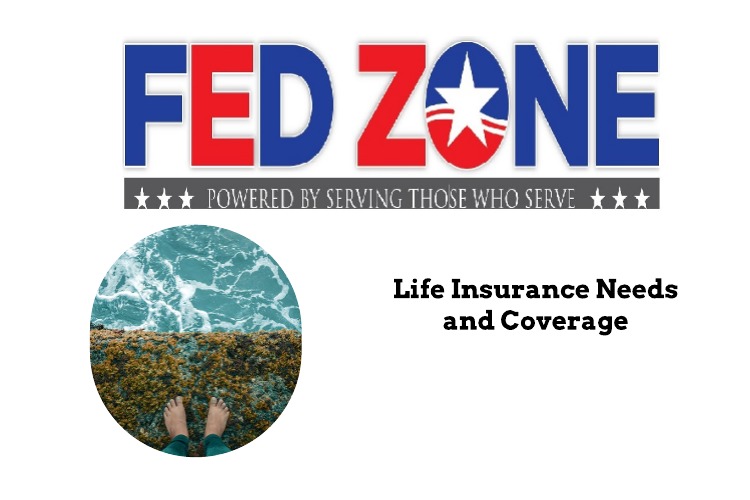Edward A. Zurndorfer–
Most federal employees who are in mid-career (they have between 10 and 20 years of federal service) likely have a need for life insurance. For example, they have a family who depends on the employee’s paycheck to pay for food, shelter, education, and anything else needed to raise a family. If the employee were to die, then what will replace the employee’s paycheck in order to pay these bills? One answer: Proceeds from a life insurance policy. Another possible reason that an employee may need life insurance is to pay off a large debt upon the employee’s death. Perhaps the largest debt many federal employees have is a mortgage that was necessary in order for the employee to buy his or her principal residence.
That being said, mid-career is a good time for many employees to evaluate their life insurance needs for the purpose of determining, among other reasons, whether they need to make changes to their current life insurance coverage. For example, they may need to obtain additional life insurance coverage that will continue into retirement and beyond. The following are some questions that mid-career employees may want to ask themselves with respect to their life insurance needs both now and into the future:
- At this point of my career, why do I need life insurance, how much coverage do I need, and for how long?
- Should I keep my Federal Employees Group Life Insurance (FEGLI) coverage, including the FEGLI “Basic Insurance Amount” (BIA) and the optional coverages (Option A – Standard, Option B – Multiple of Salary, and/or Option C – Family Coverage) or drop the part of my FEGLI life insurance (the optional coverages) and purchase life insurance from a private life insurance company?
- Are there any suggestions as to what type of life insurance (term life insurance or cash value life insurance) I should purchase from a private insurance company?
- Are there some types of term life insurance policies that I should avoid?
- What is the best way for me to go about buying life insurance?
- Are there any uses of life insurance that I should avoid?
The following example of a federal employee who is in mid-career. He has FEGLI and is evaluating his current life insurance needs and projecting ahead to see his future life insurance needs. He is considering the above questions.
Michael, age 44, is a married federal employee with two children, ages 14 and 7. Michael currently has 15 years of federal service and intends to retire from federal service at age 62. When he was age 34 ten years ago, Michael and his wife Carol bought a house. They were approved for a 30-year mortgage of $350,000. There is currently about $300,000 left on the mortgage. Michael is enrolled in FEGLI. He is enrolled in the FEGLI “Basic Insurance Amount” (equal to his SF 50 salary of $97,500 rounded up to the next $1,000 plus $2,000, or $100,000).He is also enrolled in FEGLI Option B (Multiple of SF 50 Salary adjusted to the next $1,000 plus $1,000 or $99,000) and has five multiples of his adjusted salary. Michael’s FEGLI coverage and premium cost is as follows:
Michael’s FEGLI “Basic Insurance Amount” = $100,000
Cost: $0.15/$1,000 of coverage per pay date
= 100 x .15
= $15 x 26 pay dates
= $390.00 per year
Michael’s FEGLI Option B (5 Multiples of Salary) = 5 x $99,000
Cost: $0.04/$1,000 of coverage per pay date
= 5 x 99 x .04 per pay date
= $19.80/pay date x 26 pay dates
= $514.80
Michael is currently paying in 2020 a total of $390.00 + $514.80 = $904.80 per year for $595,000 of life insurance coverage under FEGLI.
When Michael becomes age 45 in 2021, the Option B coverage increases in cost to $0.07/$1,000 of coverage per pay date, or $34.65 per pay date, or $900.90 per year (75 percent cost increase).
- Since Michael needs life insurance coverage for at least 10 to 20 years until his mortgage is paid off and his younger child is age 22, he should consider buying a 15- or a 20-year level term life insurance policy.
- Michael should contact an independent life insurance broker who will assist Michael in evaluating his life insurance needs. If Michael qualifies for and obtains a level term life insurance policy of 15 or 20 years with a face amount of $300,000 (based on what is left on his mortgage), then he should consider dropping FEGLI Option B but retain FEGLI “Basic”. This is because FEGLI “Basic” does not increase in cost that much as Michael gets older and earns a higher salary. Michael can also retain the FEGLI “Basic Insurance Amount” in retirement (at no cost) if Michael chooses to reduce the amount of that FEGLI coverage by 75 percent shortly before he retires. Starting at age 65, Michael will have free FEGLI “Basic Insurance Amount” life insurance at a reduced coverage. He can drop Option B at any time by filling out and submitting Form SF 2817.
- Since Michael’s purpose in having life insurance is temporary – to cover the balance on his mortgage which should be paid off in 15 to 20 years and for family income protection until his younger child is age 22 (15 years away)- Michael needs term life insurance. He should avoid permanent or cash value life insurance which is more expensive and does not serve a purpose at this time.
- Michael is encouraged to purchase only “level term” life insurance in which his premium remains fixed and the face amount of the life insurance remains the same. He should avoid annual renewable term life insurance in which his premiums increase over time as he gets older.
- Michael should contact an independent licensed life/health insurance broker to help him purchase a level term life insurance policy. This individual is licensed to sell life insurance in Michael’s resident state and is not affiliated with only one insurance company (that is a life insurance agent). A life insurance broker will attempt to find the best policy at the best premium price for anyone. Michael should also ask the life insurance broker to evaluate his Carol (Michael’s wife) life insurance needs at this time and recommend a new policy if necessary. Michael will not have to pay the life insurance broker for the broker’s services. The broker will get paid via a sales commission from the insurance company that issues the life insurance policy to Michael and Carol.
- One use of life insurance that individuals – especially federal employees – who are approaching their retirement date may be “sold” on is using life insurance as a substitute for a spousal survivor annuity. This is the concept of what is called “pension maximization”. The idea behind “pension maximization” is actually rather simple. A married federal employee (either covered by CSRS or FERS) at the time he retires can choose to give a CSRS or FERS survivor annuity benefit to a spouse. A survivor annuity benefit means that upon the death of the federal annuitant, the surviving spouse would receive as much as 50 percent of what the deceased annuitant was receiving at the time of his or her death. The spouse’s survivor annuity would continue until the surviving spouse dies. To give a survivor annuity benefit, the annuitant must pay for it in the form of having his or her annuity permanently reduced annually by as much as 10 percent of the starting gross annuity. This reduction continues for the life of the annuitant.
The purpose behind “pension maximization” is that the employee when he or she retires chooses not to give a survivor annuity (with the spouse’s written and notarized consent) is “saving” money because there is no reduction to his or her CSRS or FERS annuity. With the money saved in not choosing a survivor annuity benefit, the money saved can be used to buy a life insurance policy on the annuitant with the spouse as beneficiary. When the annuitant dies, the life insurance proceeds are paid to the surviving spouse as a “survivor benefit”
There are a few problems associated with “pension maximization”, namely: (1) the annuitant may not be insurable and therefore not qualify for life insurance; (2) if the annuitant is in his or her late 50’s or early 60’s, the most number of years an insurance company will insure that individual when it comes to term insurance is probably 25 years. What happens if the annuitant dies after 25 years? The surviving spouse will then receive no death benefit because the deceased spouse’s life insurance policy had terminated; (3) if the annuitant wants to apply for permanent or cash value life insurance says at age 55 or older, the premiums would be very expensive and offer not much of a death benefit; and (4) if a surviving spouse wants continued covered under the Federal Employee Health Benefits (FEHB) program upon the annuitant’s death, then the annuitant must give the spouse a survivor annuity benefit. The rule with FEHB health insurance coverage is that as long as the annuitant is alive, the annuitant’s spouse can be on the annuitant’s FEHB insurance, as part of self plus one or self and family FEHB program coverage. But at the death of the annuitant, if there is no survivor annuity benefit, then the surviving spouse loses his or her FEHB insurance coverage.
In the example, Michael is therefore strongly advised to not consider buying a life insurance policy as a substitute for a FERS survivor annuity benefit for his wife Carol.

Edward A. Zurndorfer is a Certified Financial Planner, Chartered Life Underwriter, Chartered Financial Consultant, Chartered Federal Employee Benefits Consultant, Certified Employees Benefits Specialist and IRS Enrolled Agent in Silver Spring, MD. Tax planning, Federal employee benefits, retirement and insurance consulting services offered through EZ Accounting and Financial Services, and EZ Federal Benefits Seminars, located at 833 Bromley Street – Suite A, Silver Spring, MD 20902-3019 and telephone number 301-681-1652. Raymond James is not affiliated with and does not endorse the opinions or services of Edward A. Zurndorfer or EZ Accounting and Financial Services. The information has been obtained from sources considered to be reliable, but we do not guarantee that the foregoing material is accurate or complete. While the employees of Serving Those Who Serve are familiar with the tax provisions of the issues presented herein, as Financial Advisors of RJFS, we are not qualified to render advice on tax or legal matters. You should discuss tax or legal matters with the appropriate professional.
**Life insurance policies have exclusions and/or limitations. The cost and availability of life insurance depend on factors such as age, health and the type and amount of insurance purchased. As with most financial decisions, there are expenses associated with the purchase of life insurance. Policies commonly have mortality and expense charges. In addition, if a policy is surrendered prematurely, there may be surrender charges and income tax implications. Guarantees are based on the claims paying ability of the insurance company. This case study is for illustrative purposes only. Individual cases will vary. Any information is not a complete summary or statement of all available data necessary for making an investment decision and does not constitute a recommendation. Prior to making any investment decision, you should consult with your financial advisor about your individual situation.
Life Insurance Needs
